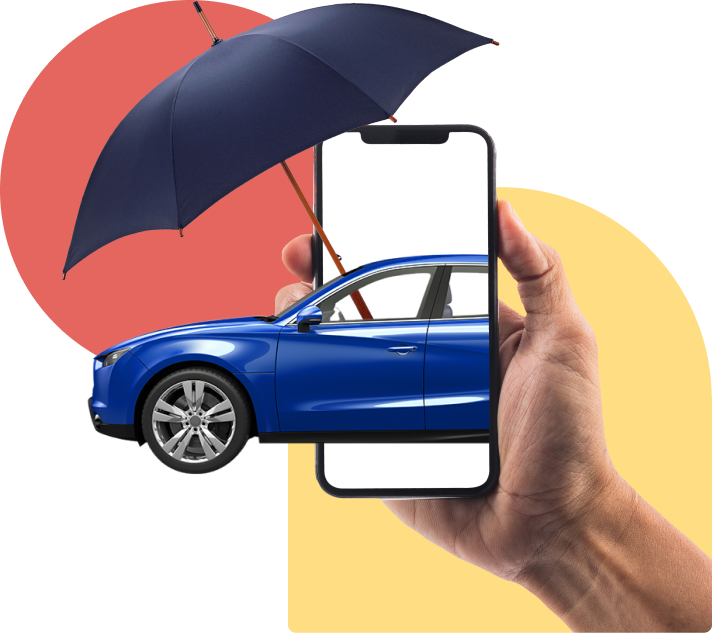
Powered by Coverage.com (NPN: 19966249)
Coverage.com, LLC is a licensed insurance producer (NPN: 19966249). Coverage.com services are only available in states where it is licensed. Coverage.com may not offer insurance coverage in all states or scenarios. All insurance products are governed by the terms in the applicable insurance policy, and all related decisions (such as approval for coverage, premiums, commissions and fees) and policy obligations are the sole responsibility of the underwriting insurer. The information on this site does not modify any insurance policy terms in any way.
Best car insurance companies for July 2024
Powered by Coverage.com (NPN: 19966249)
Coverage.com, LLC is a licensed insurance producer (NPN: 19966249). Coverage.com services are only available in states where it is licensed. Coverage.com may not offer insurance coverage in all states or scenarios. All insurance products are governed by the terms in the applicable insurance policy, and all related decisions (such as approval for coverage, premiums, commissions and fees) and policy obligations are the sole responsibility of the underwriting insurer. The information on this site does not modify any insurance policy terms in any way.
Key takeaways
- Amica and Geico tied in Bankrate’s analysis as the two best auto insurance companies overall. Progressive is the best major auto insurer for high-risk drivers.
- Auto-Owners and Nationwide are two of the best companies for budget insurance and robust discounts.
- Safeco, Travelers and USAA are three of the best auto insurance companies for personalized coverage and perks.
- State Farm and Liberty Mutual offer advantages to drivers who want to work with a local agent or bundle coverage.
- Comparing rates and reading reviews can help you identify the best auto insurer for your needs.
The best car insurance companies in 2024
The best car insurance companies offer rates, coverage options, discounts and digital tools that fit your individual needs. Our research revealed that these 10 insurers are some of the top car insurance companies available. We’ve highlighted standout features from each company to help you decide which insurer fits your specific needs. Your car insurance needs are unique to your situation, so understanding those needs before you compare auto insurance companies is an important step to finding the best rates and coverage.
| Insurance company | Best for |
Bankrate Score
Bankrate Scores primarily reflect a weighted rank of industry-standard ratings for financial strength and customer experience in addition to analysis of quoted annual premiums from Quadrant Information Services, spanning all 50 states and Washington, D.C.
Bankrate Scores primarily reflect a weighted rank of industry-standard ratings for financial strength and customer experience in addition to analysis of quoted annual premiums from Quadrant Information Services, spanning all 50 states and Washington, D.C.
|
|
|---|---|---|---|
|
Best overall
|
4.6
|
||
|
Best overall
|
4.4
|
||
|
Best for high-risk drivers
|
4.4
|
||
|
Best for added perks
|
4.3
|
||
|
Best for coverage on a budget
|
4.3
|
||
|
Best for local agencies
|
4.3
|
||
|
Best for personalized coverage
|
4.2
|
||
|
Best for military-focused coverage
|
4.2
|
||
|
Best for discounts
|
4.0
|
||
|
Best for bundling numerous products
|
3.8
|
Powered by Coverage.com (NPN: 19966249)
Coverage.com, LLC is a licensed insurance producer (NPN: 19966249). Coverage.com services are only available in states where it is licensed. Coverage.com may not offer insurance coverage in all states or scenarios. All insurance products are governed by the terms in the applicable insurance policy, and all related decisions (such as approval for coverage, premiums, commissions and fees) and policy obligations are the sole responsibility of the underwriting insurer. The information on this site does not modify any insurance policy terms in any way.
Amica

Best auto insurance company overall (tie)


4.6
4.6
Avg. full coverage premium
$236/mo
Avg. full coverage premium
$2,832/yr
Customer satisfaction
909/1,000
-
Why this company made our list: Amica’s exceptional claims service and customer-centric business model make it a standout choice for drivers seeking a top auto insurance company that will be there when you need it most, based on Bankrate’s analysis. In fact, Amica tied with Geico for the Best Auto Insurance Company Overall in the 2024 Bankrate Awards. You can learn more about Amica and obtain a quote at amica.com or by calling 1-800-242-6422.
Availability: Available in all states except Hawaii.
Geico

Best auto insurance company overall (tie)


4.4
4.4
Avg. full coverage premium
$168/mo
Avg. full coverage premium
$2,012/yr
Customer satisfaction
874/1,000
-
Why this company made our list: Geico's long history as a trusted, household-name auto insurer is reflected in its high Bankrate Score. Coverage is available for virtually every type of driver, making its car insurance coverage generally accessible, even for consumers with blemished driving histories. Geico’s winning combination of metrics helped it tie for the Best Auto Insurance Company Overall in our 2024 Bankrate Awards. The insurer also won in the Best Budget Auto Insurance Company and Best for Young Drivers categories.
Availability: Available in all 50 states
Progressive

Best car insurance company for high-risk drivers


4.4
4.4
Avg. full coverage premium
$155/mo
Avg. full coverage premium
$1,865/yr
Customer satisfaction
870/1,000
-
Why this company made our list: Progressive is the second-largest auto insurance company in the country, dominating just over 14 percent of the market. Its nationwide availability and extensive list of coverage options make it a great choice for all types of drivers, even those who have a DUI conviction and need their insurer to file an SR-22 or FR-44 on their behalf. For that reason, we chose Progressive as the Best Auto Insurance Company for High-Risk Drivers in the 2024 Bankrate Awards.
Availability: Available in all 50 states.
Safeco
Best for added perks


4.3
4.3
Avg. full coverage premium
Not available
Avg. full coverage premium
Not available
Customer satisfaction
865/1,000
-
Why this company made our list: Our industry experience has taught us that the best car insurance company offers more than just the cheapest rates. Instead, some drivers may want to consider the overall value their company can provide. Although average rates aren’t available for Safeco, the company offers numerous perks that may pique your interest. From its extensive list of unique add-on coverage options, like its claims-free cash back and diminishing deductible offerings, to its networks of local agents, you may want to consider Safeco if you value a breadth of coverage options.
Availability: Available in all states except Alaska, Delaware and Hawaii.
Auto-Owners

Best budget auto insurance company (tie)


4.3
4.3
Avg. full coverage premium
$141/mo
Avg. full coverage premium
$1,695/yr
Customer satisfaction
865/1,000
-
Why this company made our list: If you live in one of the 26 states where Auto-Owners writes car insurance policies, you might want to include it on your list. Not only does Auto-Owners have a low NAIC complaint index, but it also received a top AM Best rating for financial strength. Young drivers and teens may want to pay special attention to Auto-Owners: it offers three different student discounts and fairly competitive rates for drivers 25 and under. But drivers older than 25 can likely find good deals with Auto-Owners, as well. Auto-Owners also tied with Geico for Best Budget Auto Insurance Company.
Availability: Available in 26 states.
State Farm
Best for local agents


4.3
4.3
Avg. full coverage premium
$210/mo
Avg. full coverage premium
$2,524/yr
Customer satisfaction
882/1,000
-
Why this company made our list: As the largest national auto insurer based on market share, State Farm's reach and reputation make it one of the best auto insurance companies for drivers in most states. Its extensive local agent network showcases its customer-first approach to providing consumers with various personal and commercial insurance products.
Availability: Available in all states except MA and RI.
Travelers
Best for personalized coverage


4.2
4.2
Avg. full coverage premium
$151/mo
Avg. full coverage premium
$1,810/yr
Customer satisfaction
854/1,000
-
Why this company made our list: Travelers has over 150 years of experience in the auto insurance industry. Its vast independent agent network, numerous endorsement options, robust savings opportunities and proven financial track record make it a worthwhile option for drivers nationwide.
Availability: Available in 42 states and Washington D.C.
USAA
Best for military-focused coverage


4.2
4.2
Avg. full coverage premium
$161/mo
Avg. full coverage premium
$1,931/yr
Customer satisfaction
890/1,000
-
Why this company made our list: USAA cannot officially qualify for J.D. Power rankings because of its strict eligibility requirements; the company is only available to active-duty military, veterans and their eligible family members. However, it is still included in J.D. Power’s customer satisfaction and claims satisfaction studies — and is a frequent top scorer. Additionally, USAA has impressive financial strength ratings from Moody's, AM Best and S&P. Our analysis shows that this company could be the best for military-focused benefits, including a discount of up to 60 percent for qualifying military members who put their vehicles in storage while deployed.
Availability: Available in all 50 states.
Nationwide
Best for discounts


4
4
Avg. full coverage premium
$159/mo
Avg. full coverage premium
$1,909/yr
Customer satisfaction
868/1,000
-
Why this company made our list: Nationwide is known for its innovative programs and wide coverage options that may suit diverse budgets and goals. You might also be able to take advantage of multiple potential discounts and leverage the company’s robust digital resources to help you manage your policy. Customers might also benefit from features such as “On Your Side” service, Nationwide’s free annual insurance consultation that pairs policyholders with a licensed agent to be proactive about adapting your insurance to your needs.
Availability: Available in all states except Alaska, Hawaii and Louisiana.
Liberty Mutual
Best for bundling numerous products


3.8
3.8
Avg. full coverage premium
Not available
Avg. full coverage premium
Not available
Customer satisfaction
870/1,000
-
Why this company made our list: Liberty Mutual auto insurance can be a great option for those who want the convenience of housing multiple policies with one insurer. Not only is bundling a practical choice, but it can also help save. Liberty Mutual advertises that drivers who switch and bundle their home and auto policies together can save up to $950 annually. Liberty Mutual’s average car insurance rates are not available, so you must contact a Liberty Mutual agent for a quote.
Availability: Available in all 50 states.
Why you can trust Bankrate
Read our full methodologyTo help you find the best car insurance company, Bankrate’s insurance editorial team reviewed some of the largest insurers by market share. We based our picks on a well-rounded analysis of several metrics related to each company. Our review also highlights standout discounts to help drivers understand how to optimize their insurance rates. Keep in mind, though, that discount amounts and eligibility requirements vary based on state regulations, driver profiles and the company you choose.
46
years of industry expertise
122
carriers reviewed
34.5K
ZIP codes examined
1.2M
quotes analyzed
The best auto insurance companies by state
While we stand by our picks for the top car insurance companies on a national level, it is important to know that the best insurers will vary by state. To determine the best auto insurance company in your state, you’ll want to look at more than just each carrier’s average cost of car insurance.
Although average price is important, third-party customer satisfaction scores can vary widely between regions. This means that one company might shine in one part of the country but not fare as well in another. To help you find the best car insurance in your state, Bankrate conducted extensive research into the car insurance markets in all 50 states and Washington, D.C. and evaluated the largest carriers by market share using our proprietary Bankrate Score method.
Car insurance rates by state
To assist our readers no matter where they live, we’ve created the interactive map below of car insurance rates by state. With an understanding of the average rates in your state, you can get a better idea of what’s considered a normal price range for your policy.
| State | Avg. annual full coverage premium | Avg. annual min. coverage premium |
|---|---|---|
|
Avg. annual full coverage premium
$1,965
|
Avg. annual min. coverage premium
$477
|
|
|
Avg. annual full coverage premium
$2,292
|
Avg. annual min. coverage premium
$491
|
|
|
Avg. annual full coverage premium
$2,547
|
Avg. annual min. coverage premium
$755
|
|
|
Avg. annual full coverage premium
$2,156
|
Avg. annual min. coverage premium
$431
|
|
|
Avg. annual full coverage premium
$2,573
|
Avg. annual min. coverage premium
$638
|
|
|
Avg. annual full coverage premium
$2,933
|
Avg. annual min. coverage premium
$536
|
|
|
Avg. annual full coverage premium
$2,431
|
Avg. annual min. coverage premium
$930
|
|
|
Avg. annual full coverage premium
$2,335
|
Avg. annual min. coverage premium
$839
|
|
|
Avg. annual full coverage premium
$3,430
|
Avg. annual min. coverage premium
$1,048
|
|
|
Avg. annual full coverage premium
$2,469
|
Avg. annual min. coverage premium
$835
|
|
|
Avg. annual full coverage premium
$1,588
|
Avg. annual min. coverage premium
$376
|
|
|
Avg. annual full coverage premium
$1,301
|
Avg. annual min. coverage premium
$331
|
|
|
Avg. annual full coverage premium
$2,100
|
Avg. annual min. coverage premium
$549
|
|
|
Avg. annual full coverage premium
$1,646
|
Avg. annual min. coverage premium
$390
|
|
|
Avg. annual full coverage premium
$1,775
|
Avg. annual min. coverage premium
$324
|
|
|
Avg. annual full coverage premium
$2,538
|
Avg. annual min. coverage premium
$586
|
|
|
Avg. annual full coverage premium
$2,632
|
Avg. annual min. coverage premium
$762
|
|
|
Avg. annual full coverage premium
$3,606
|
Avg. annual min. coverage premium
$940
|
|
|
Avg. annual full coverage premium
$1,462
|
Avg. annual min. coverage premium
$384
|
|
|
Avg. annual full coverage premium
$2,544
|
Avg. annual min. coverage premium
$906
|
|
|
Avg. annual full coverage premium
$1,673
|
Avg. annual min. coverage premium
$460
|
|
|
Avg. annual full coverage premium
$2,887
|
Avg. annual min. coverage premium
$872
|
|
|
Avg. annual full coverage premium
$2,410
|
Avg. annual min. coverage premium
$667
|
|
|
Avg. annual full coverage premium
$2,090
|
Avg. annual min. coverage premium
$479
|
|
|
Avg. annual full coverage premium
$2,591
|
Avg. annual min. coverage premium
$683
|
|
|
Avg. annual full coverage premium
$2,458
|
Avg. annual min. coverage premium
$386
|
|
|
Avg. annual full coverage premium
$2,320
|
Avg. annual min. coverage premium
$571
|
|
|
Avg. annual full coverage premium
$2,983
|
Avg. annual min. coverage premium
$943
|
|
|
Avg. annual full coverage premium
$1,600
|
Avg. annual min. coverage premium
$434
|
|
|
Avg. annual full coverage premium
$2,352
|
Avg. annual min. coverage premium
$958
|
|
|
Avg. annual full coverage premium
$2,212
|
Avg. annual min. coverage premium
$532
|
|
|
Avg. annual full coverage premium
$3,587
|
Avg. annual min. coverage premium
$1,502
|
|
|
Avg. annual full coverage premium
$1,827
|
Avg. annual min. coverage premium
$536
|
|
|
Avg. annual full coverage premium
$1,767
|
Avg. annual min. coverage premium
$358
|
|
|
Avg. annual full coverage premium
$1,482
|
Avg. annual min. coverage premium
$397
|
|
|
Avg. annual full coverage premium
$2,617
|
Avg. annual min. coverage premium
$509
|
|
|
Avg. annual full coverage premium
$1,872
|
Avg. annual min. coverage premium
$751
|
|
|
Avg. annual full coverage premium
$2,464
|
Avg. annual min. coverage premium
$512
|
|
|
Avg. annual full coverage premium
$2,667
|
Avg. annual min. coverage premium
$803
|
|
|
Avg. annual full coverage premium
$1,812
|
Avg. annual min. coverage premium
$590
|
|
|
Avg. annual full coverage premium
$2,222
|
Avg. annual min. coverage premium
$338
|
|
|
Avg. annual full coverage premium
$1,890
|
Avg. annual min. coverage premium
$461
|
|
|
Avg. annual full coverage premium
$2,404
|
Avg. annual min. coverage premium
$680
|
|
|
Avg. annual full coverage premium
$2,037
|
Avg. annual min. coverage premium
$754
|
|
|
Avg. annual full coverage premium
$1,385
|
Avg. annual min. coverage premium
$292
|
|
|
Avg. annual full coverage premium
$1,996
|
Avg. annual min. coverage premium
$663
|
|
|
Avg. annual full coverage premium
$1,575
|
Avg. annual min. coverage premium
$479
|
|
|
Avg. annual full coverage premium
$2,055
|
Avg. annual min. coverage premium
$531
|
|
|
Avg. annual full coverage premium
$1,718
|
Avg. annual min. coverage premium
$410
|
|
|
Avg. annual full coverage premium
$1,708
|
Avg. annual min. coverage premium
$259
|
|
|
Avg. annual full coverage premium
$2,408
|
Avg. annual min. coverage premium
$744
|
Car insurance industry trends: Premium increases likely to continue
Full coverage car insurance premiums are at $2,278 in 2024, and rates will likely continue increasing this year.
As rates rise, it’s important to understand how different auto industry costs are interconnected. The cost of car parts has increased over the past few years, largely because of ongoing shortages and shipping delays. When a claim occurs, the higher cost of car parts is also met with higher labor costs, leading to insurers paying more for each claim. Higher claims costs, paired with a higher number of claims because of poor post-pandemic driving habits, causes insurance companies to pay more expensive claims more often.
This cycle results in insurance companies filing rate hikes to build back their reserves, leading to higher car insurance premiums for policyholders. Since rate filings must get approved by the state first, policyholders don’t see these increased premiums until their policy renews after those rate hikes are approved.
Our industry experts weigh in
Mark Friedlander
Director of corporate communications, Insurance Information Institute
“Car insurance rates are expected to continue to increase in 2024 due to more costly repairs, driven by parts shortages and higher costs of labor, as well as low inventories of vehicles, which generates higher costs of replacing totaled cars. From 2020 through 2023, replacement costs increased an average of 45 percent cumulatively, whereas inflation for the overall U.S. economy increased 15 percent within the same timeframe. Triple-I forecasts the U.S. personal auto insurance industry to post a substantial underwriting loss in 2023 with a 110.5 combined ratio, meaning auto insurers are paying out more than $1.10 for every dollar collected in premium. This is a slight improvement over the industry’s 112.2 combined ratio in 2022. A key factor in determining underwriting profit is accident severity. Since the pandemic began in 2020, loss costs for accidents have been outpacing premiums charged, resulting in many insurers raising rates multiple times to offset losses. We are starting to see premiums catching up with loss costs. Unless replacement cost begins to decrease materially — which is not currently forecast — we expect the personal auto insurance line to remain at an underwriting loss through 2025."
What are the different types of car insurance?
One of the first steps to finding the best auto insurance for you is to understand your needs. That starts with learning about the key coverage options available and how these options work together to provide financial protection.
- Bodily injury liability coverage helps pay for injuries incurred by the other driver and their passengers in an at-fault accident. Almost all states in the U.S. require you to carry bodily injury and property damage liability insurance in order to drive legally.
- Property damage liability coverage helps pay for repairs to the other driver's car or any property you damage in an accident that you are found to have caused. This may include stationary objects such as fences or lampposts.
- Uninsured and underinsured motorist coverage helps pay for your injuries (and, in some states, your property damage) if it was caused by a driver who either lacks sufficient coverage or any coverage at all.
- Personal injury protection (PIP), also known as no-fault insurance and only available in certain states, pays for medical expenses you and your passengers incur following an accident, regardless of fault. It also accounts for non-medical expenses incurred as a result of an accident, such as lost wages or the cost of childcare.
- Medical payments coverage is similar to PIP insurance coverage but includes only payments for medical expenses. It is required in some states and optional in others.
- Comprehensive coverage is for a broad range of non-collision-related damage. This can include vehicle theft, fire, weather damage and more. Comprehensive coverage can also help if you hit an animal.
- Collision coverage helps cover damage to your vehicle if you’re involved in a collision, whether you hit another vehicle, a stationary object or a pedestrian.
While the main types of car insurance coverage are listed above, every carrier is different and may offer unique or specialized coverage options. For instance, if you purchase a brand-new vehicle, you may be interested in new car replacement coverage. Or, if the roads near you are full of potholes that could pop your tire, roadside assistance might be worth looking into. Speaking with your agent and reviewing your options online can help you find coverage tailored to your needs.
Minimum vs. full coverage car insurance
Minimum and full coverage insurance are terms commonly used to describe an auto insurance policy. Understanding the vast distinction between the two is paramount when searching for the right levels of financial protection.
Minimal coverage refers to a bare-bones policy that carries only the state-mandated insurance limits. Typically, this includes only bodily injury and property damage liability at the lowest limits allowed, but depending on state coverage requirements can also include other coverage types, such as personal injury protection. This option covers damage to others up to the policy limit but does not pay for damage to your vehicle if you are at fault for an accident, which is one reason it is usually the cheapest available option.
A policy with liability limits higher than the state requires but without physical damage coverage, would be considered a liability-only policy instead of a minimal coverage policy.
Full coverage insurance includes liability coverage plus comprehensive and collision coverage. The limit of liability can range from state minimums up to the highest option available by the insurance provider, but the key difference is that a full coverage policy provides financial protection for your vehicle whether you are at fault for an accident, a victim of theft or vandalism or experience weather damage.
Since there isn't an industry-standard definition of full coverage, some insurance providers may add roadside assistance, gap insurance and rental reimbursement to your policy if you request full coverage, so work closely with your agent and read your paperwork carefully to avoid paying for more coverage than you need.
Should you get minimum or full coverage car insurance?
The right coverage amount for you will strike a balance between how much you can reasonably afford for your policy and how much financial risk you’re willing to assume. If you're mostly concerned with getting a cheap premium, then a minimum coverage car insurance policy might work best for you: it meets your state’s legal insurance requirements and almost always costs less than full coverage. Plus, minimum coverage could be the best insurance for older cars or ones near the end of their driveable years. However, with minimum coverage, you could wind up with significantly higher out-of-pocket costs after an accident. This kind of car insurance only helps pay for the damage you cause in an accident. If you’re at fault for an accident and there’s damage done to your vehicle, you would be left footing the bill on your own.
A full coverage car insurance policy will increase your premium, but it comes with broader protection for your vehicle and finances. Vehicle repairs and medical expenses after an accident can get expensive fast, and purchasing more car insurance coverage can act as a valuable financial safety net. Bankrate found that only 44 percent of U.S. adults are able to spend $1,000 or more from their emergency savings. With that in mind, many insurance experts suggest opting for full coverage or at least purchasing higher liability limits than the state minimums.
Car insurance basics
What factors impact the cost of car insurance?
The coverage you choose is not the only thing that influences the cost of your policy. Insurance providers use unique underwriting algorithms to determine how much of a risk you are to insure and the likelihood that you will file a claim. Not all carriers weigh each factor the same, and they may not be able to take certain factors into account depending on your state’s laws.
- Driving record: In general, drivers with a clean driving record will be awarded the lowest possible rates by insurers, since they are considered to be at low risk for accidents or other claims. If you have any moving violations such as speeding tickets or DUIs, on the other hand, you may not be offered low rates. In some cases, individuals with multiple infractions may be considered high-risk drivers, which could lead to some insurers turning them down for coverage.
- Age and driving experience: Younger drivers have less experience on the road, leading to a higher accident frequency. This can often lead to higher car insurance rates. Unless you’re in Hawaii or Massachusetts, which ban age as a rating factor, the best company for drivers insuring young drivers may be ones that offer student or telematics discounts to offset premium increases.
- State and city: Your location plays a primary role in determining rate. Drivers who live in busy urban areas, for example, where car theft is common and congested traffic leads to an increased rate of accidents, may pay more than those in more suburban or rural areas. A state's insurance laws also may influence rates. Even your car's location when parked — in a garage or on the street — can affect your rate.
- Vehicle make and model: The best insurance for cars with easy-to-source replacement parts may be cheaper than ones for more high-end vehicles. Driving a vehicle that comes equipped with safety features may also help you save on insurance.
- Credit-based insurance score: Unless you live in California, Hawaii, Massachusetts or Michigan, your credit history will factor into your insurance premium. Drivers with poor credit generally pay more, while drivers with good or excellent credit tend to pay less.
- Insurance lapse history: If you’ve allowed your car insurance coverage to lapse, your insurer may charge more for your policy. A lapse in coverage could signal that you are a higher-risk driver and therefore more likely to file a costly claim.

How much does car insurance cost?
Proprietary data from Quadrant Information Services indicate that the national average cost of car insurance currently sits at $2,278 per year for a full coverage policy and $621 for minimum coverage. However, these figures are just a baseline. Car insurance is highly individualized, and rates vary based on numerous personal factors.
Location is just one of those factors. In general, states that pose higher risks for filing claims (whether that is due to elevated levels of vehicle theft, extreme weather, traffic congestion, poor highway infrastructure or something else) will likely see higher average car insurance rates.
Driving incidents can also affect the total cost of your car insurance. Drivers with speeding tickets could see their premiums cost more compared to drivers with clean records. Your state’s laws and your age, gender and credit history can also determine how much you pay for car insurance. For a more specific overview, you might want to research the average insurance cost in your state.
| Insurance company | Annual full coverage premium | Monthly full coverage premium |
|---|---|---|
|
$2,012
|
$168
|
|
|
$2,832
|
$236
|
|
|
$1,931
|
$161
|
|
|
$1,695
|
$141
|
|
|
$2,524
|
$210
|
|
|
$1,865
|
$155
|
|
|
$1,909
|
$159
|
|
|
$1,810
|
$151
|
Powered by Coverage.com (NPN: 19966249)
Coverage.com, LLC is a licensed insurance producer (NPN: 19966249). Coverage.com services are only available in states where it is licensed. Coverage.com may not offer insurance coverage in all states or scenarios. All insurance products are governed by the terms in the applicable insurance policy, and all related decisions (such as approval for coverage, premiums, commissions and fees) and policy obligations are the sole responsibility of the underwriting insurer. The information on this site does not modify any insurance policy terms in any way.
| Insurance company | Annual min coverage premium | Monthly min coverage premium |
|---|---|---|
|
$547
|
$46
|
|
|
$713
|
$59
|
|
|
$537
|
$45
|
|
|
$439
|
$37
|
|
|
$792
|
$66
|
|
|
$594
|
$50
|
|
|
$664
|
$55
|
|
|
$508
|
$42
|
Powered by Coverage.com (NPN: 19966249)
Coverage.com, LLC is a licensed insurance producer (NPN: 19966249). Coverage.com services are only available in states where it is licensed. Coverage.com may not offer insurance coverage in all states or scenarios. All insurance products are governed by the terms in the applicable insurance policy, and all related decisions (such as approval for coverage, premiums, commissions and fees) and policy obligations are the sole responsibility of the underwriting insurer. The information on this site does not modify any insurance policy terms in any way.
Why is car insurance so expensive?
There’s no single answer for the cost of car insurance. Inflation does factor into it, but it’s not the only thing making car insurance more expensive. For the past several years, insurance companies have been facing high loss ratios, meaning they are paying out more money in claims than they intake in premiums. To stay in the green, insurance companies are all but forced to raise rates — even for drivers without claims or coverage changes.
High levels of vehicle theft have also made car insurance more expensive in recent years. 2022 saw one million vehicle thefts, the highest recorded number since 2008. Because the risk of vehicle theft is higher than usual, insurers usually raise comprehensive coverage costs to account for it. Repair costs are another element; as vehicles become more high-tech, they also become more expensive to fix after an accident. By the end of 2022, the average cost of vehicle repairs was up 12 percent.
How to find the best rates on car insurance
Although you can’t control some of the factors that are used to determine the cost of your car insurance, there are a few things you can do to help secure a competitive rate:
- Shop around: Car insurance companies use unique rating algorithms to determine your premium, so you’ll get a different rate with each carrier. You may wind up paying a lower premium if you take a little extra time to compare auto insurance companies.
- Shop early: Shopping up to a month ahead of your renewal date can be helpful, as it allows you time to gather quotes and make a decision. Most companies require at least a month’s down payment, so make sure you account for that in your budget.
- Utilize discounts: Most carriers, from the top auto insurance companies to local agencies, offer their customers a selection of discounts. Exact offerings and eligibility will vary among providers.
- Participate in a telematics program: A telematics device or app tracks your driving habits. If you drive safely and obey traffic laws, your insurer might reward you with a discount.
- Keep a clean driving record: At-fault accidents and tickets are signs that you may engage in risky driving behaviors and can significantly increase your rates.
- Consider your vehicle: While not the most practical step for everyone, you could consider shopping for a different vehicle if you need to lower your rates drastically.
- Set realistic expectations: Not all drivers will be able to score an amazing deal on their insurance. For example, if you have a DUI conviction on your record, data show that average rates for a full coverage policy can be up to 98 percent more.

Types of car insurance discounts
When navigating the world of insurance, being aware of discount opportunities can help you find the best auto insurance and significantly reduce your overall premium. When comparing auto insurance companies, keep in mind that not every discount is available in every state and eligibility requirements change depending on your provider.
Here are some of the best car insurance discounts to ask your insurance agent about:
Frequently asked questions
Methodology
Bankrate utilizes Quadrant Information Services to analyze July 2024 rates for all ZIP codes and carriers in all 50 states and Washington, D.C. Rates are weighted based on the population density in each geographic region. Quoted rates are based on a single, 40-year-old male and female driver with a clean driving record, good credit and the following full coverage limits:
- $100,000 bodily injury liability per person
- $300,000 bodily injury liability per accident
- $50,000 property damage liability per accident
- $100,000 uninsured motorist bodily injury per person
- $300,000 uninsured motorist bodily injury per accident
- $500 collision deductible
- $500 comprehensive deductible
To determine minimum coverage limits, Bankrate used minimum coverage that meets each state’s requirements. Our base profile drivers own a 2022 Toyota Camry, commute five days a week and drive 12,000 miles annually.
These are sample rates and should only be used for comparative purposes.
Bankrate Scores
Our 2024 Bankrate Score considers variables our insurance editorial team determined impacts policyholders’ experiences with an insurance company. These rating factors include a robust assessment of each company’s product availability, financial strength ratings, online capabilities and customer and claims support accessibility. Each factor was added to a category, and these categories were weighted in a tiered approach to analyze how companies perform in key customer-impacting categories.
Each category was assigned a metric to determine performance, and the weighted sum adds up to a company’s total Bankrate Score — out of 5 points. Our scoring model provides a comprehensive view, indicating when companies excel across several key areas and highlighting where they fall short.
-
Cost & ratings 50%
-
Coverage & savings 30%
-
Support 20%
- Tier 1 (Cost & ratings): To determine how well auto and home insurance companies satisfy these priorities, average quoted premiums from Quadrant Information Services (if available), as well as any of the latest third-party agency ratings from J.D. Power, AM Best, Demotech and the NAIC, were analyzed.
- Tier 2 (Coverage & savings): We assessed companies’ coverage options and availability to help policyholders find a provider that balances cost with coverage. Additionally, we evaluated each company’s discount options listed on its website.
- Tier 3 (Support): To encompass the many ways an auto insurance company can support policyholders, we analyzed avenues of customer accessibility along with community support. This analysis incorporated additional financial strength ratings from S&P and Moody’s and factored a company’s corporate sustainability efforts.



